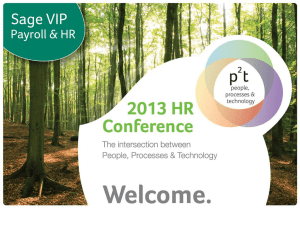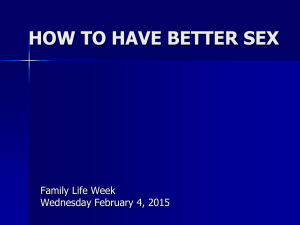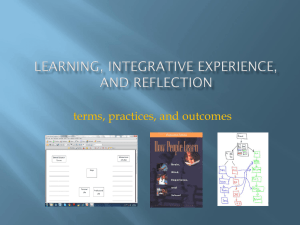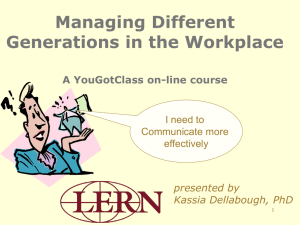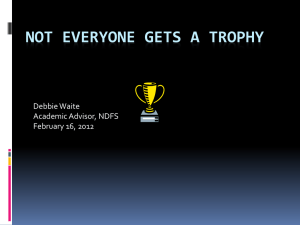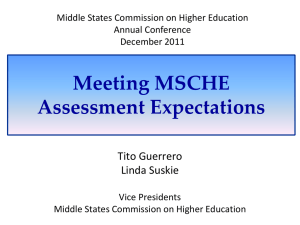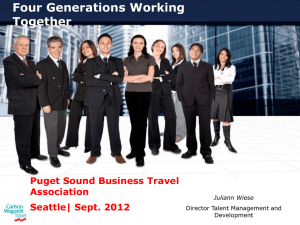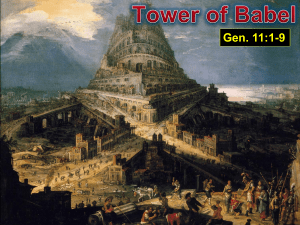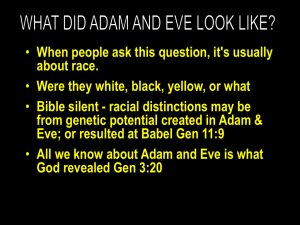Double-take: A Two Generation Approach to Poverty
advertisement
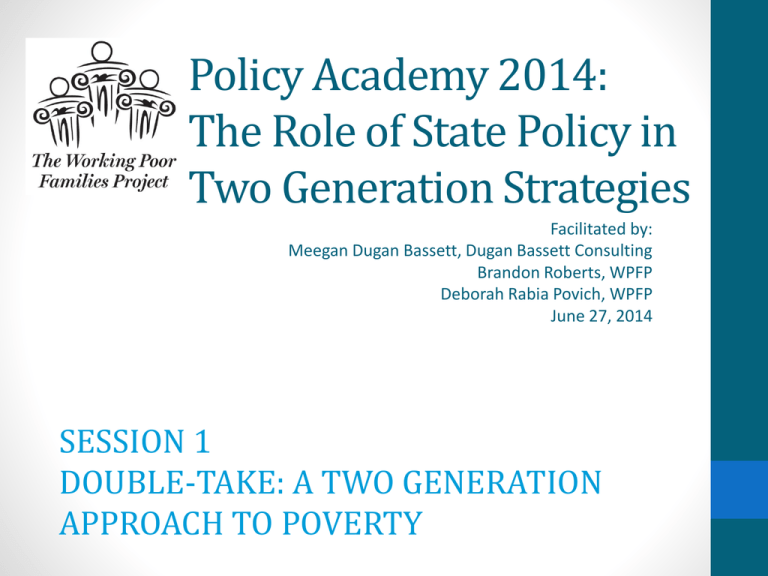
Policy Academy 2014: The Role of State Policy in Two Generation Strategies Facilitated by: Meegan Dugan Bassett, Dugan Bassett Consulting Brandon Roberts, WPFP Deborah Rabia Povich, WPFP June 27, 2014 SESSION 1 DOUBLE-TAKE: A TWO GENERATION APPROACH TO POVERTY Meegan Dugan Bassett, Dugan Bassett Consulting THE BASICS: A 2 GEN OVERVIEW The 2 Gen Approach Programs and policies that help both parents and children build skills, education, or other resources needed to break out of poverty. Why Is WPFP Interested in 2 Gen Strategies? The War on Poverty Isn’t Over • 18 mil children (<13) and 24.3 mil adults live in low-income working families (<200% of FPL). • Nearly 40% of children in working families are low-income. • The percentage of families with children living below the FPL has risen from 15.6% in 1965 to 18.4% in 2012. Source: WPFP, analysis by PRB from ACS 2012; U.S. Census Historical Tables Our Interest in 2 Gen • WPFP’s focus to improve low-income parents’ economic success, combined with efforts to support children’s development can break the cycle of poverty. • Adult-focused state systems and policies can contribute to more effective 2 Gen strategies. The 1960’s-1980’s 2 Gen Theory of Change Problem Definition: Low-income children need preparation for school and social capital to break out of poverty as adults. Early Childhood Education Better Literacy Better School Outcomes Better Future Income Parenting Education The 1990’s: An Era of Change in 2 Gen • The Foundation for Child Development coins term “TwoGeneration” • Additional federal funding drives flurry of new early childhood 2 Gen programs • 2 Gen progress halted by influx of work-first policies and a negative, disputed evaluation The 1990’s: Major Changes in Federal 2 Gen Policies 1960’s1980’s 1990’s 2000’s2010’s Head Start and the Child and Family Resource Program Child Care Development Fund (CCDBG) Early childhood care + parent support Early Head Start (Dept of Ed) Early childhood + parenting skills + GED and/or job search The Comprehensive Child Development Program (DHHS) wrap-around social and educational services for families of newborns Head Start Family Service Centers (DHHS) Early childhood + case managers + adult literacy + substance abuse + employment training services TANF job readiness + job search resources on custodial + changes child support enforcement SCHIP (DHHS) health insurance for children Early Childhood Comprehensive Grants U.S. Dept of Ed. Promise Neighborhoods Child Support Parent Employment Demonstration Project The New Wave 2 Gen Theory of Change High Quality Early Childhood Education Better School Preparation and Performance Parenting Education Adult Education, Sector Training, or Higher Education for Parents Wrap-Around Family Supports Long-term economic stability for children and parents Parents and Families Are More Economically Stable Key Groups Working On 2 Gen Federal and State Efforts Philanthropy Researchers National Groups Local Efforts Government Policymakers and Philanthropists Federal and State Efforts • Federal efforts were the initial driver of 2 Gen programs, primarily in child serving systems. • Current state efforts, include legislation in three states and other policy changes in several states. Most have focused on child serving systems. Philanthropy • Annie E. Casey Foundation, W. K. Kellogg Foundation, Foundation for Child Development, Gates Foundation, and the George Kaiser Foundation have all included a 2 Gen approach in their grant making. National Groups Leading the Charge Ascend • This national initiative stimulated a new conversation about this approach with funding for programs and research and a group of Ascend fellows. Center for Study of Social Policy • In 2006, CSSP launched the Strengthening Families Initiative to help state early education and child protection services end child abuse by supporting greater family resources and resiliency. Local Efforts Primarily based in: • Early childhood education centers- These programs usually include: parenting skills, adult education, or sector training • Career Advance at the Community Action Project Tulsa • Even Start and All Our Kin in Connecticut • Connected to community colleges or post-secondary institutions- These primarily focus on parent educational attainment, with resources for the family (housing, childcare, etc.) • Endicott College Keys to Degrees • Buckner Family Place • Jeremiah Program • Community based organizations- include multiple services • Atlanta Civic Site Federal Policy Started 2 Gen State Policy Can Expand It Programs State Policy • Impact small number of families • Unable to set priorities and regulations for funding sources • Limited resources, networks, and expertise • Broader reach through agency policy, funding, and practice • Multiple sources of funding, ability to set priorities and regulations • Access to a broad network of offices, case managers, and community based organizations Helpful 2 Gen Publications Title/Source Description Two Generation Programs in the TwentyFirst Century P. Lindsay Chase-Lansdale and Jeanne Brooks-Gunn The Future of Children, Volume 24, Issue 1 Spring 2014 The authors describe the research behind 2 Gen programs over the years, focusing on programs that explicitly engage both parents and children in building human capital. An excellent overview of the two waves of 2 Gen programs, the authors describe the history, theories of change, and research behind this approach. They also discuss challenges to 2 Gen programs, where the research is lacking, and summarize many current programs. Does reference policy, but does not have a strong state policy component. Two (or More) Generation Framework: A Look Across and Within. Janice M. Gruendel. Center for the Study of Social Policy (2014) This piece provides a useful overview of most of the top 2 Gen initiatives, with the core goals, target populations, and program examples for each. Provides an overview of the Chris King getting started guide for policymakers as well. Includes embedded hyperlinks to multiple program examples and publications all in one place. Investing in Children and Parents: Fostering Two-Generation Strategies in the United States Christopher T. King, Tara C. Smith, & Robert W. Glover. Ray Marshall Center, University of Texas-Austin (2011) Based on their work with 2 Gen programs that combine early childhood education and sectoral workforce training for parents, this paper has an excellent summary of federal sources of funds that can be leveraged at the state level to create new 2 Gen policies and programs. Also includes a summary of some of the current programs combining workforce training or higher education and family supports. There are multiple versions of this paper, but the one found on the Ascend website is the most robust. Helpful 2 Gen Publications (continued) Title/Source Description Gateways to Two-Generations: The Potential for Early Childhood Education and Partnerships to Support Children and Parents Together Joan Lombardi, Anne Mosle, Nisha Patel, Rachel Schumacher, and Jennifer Stedron. Ascend (2014) This publication from Ascend provides a strong overview their current 2 Gen approach. Includes useful data on children and parents in poverty, background information on programs and policies that started the approach, and examples of current 2 Gen programs. There is a small section with some useful ideas for state policy. Promoting Two-Generation Strategies: A Getting-Started Guide for State and Local Policymakers Christopher T. King, Rheagan Coffey, and Tara C. Smith. Ray Marshall Center, University of Texas-Austin (2013) Although this piece is focused on a specific type of 2 Gen program, it has useful summaries of existing efforts and provides practical steps state policymakers can take to replicate the early childhood education/sectoral training model. Includes some helpful ideas for available funding and examples of existing infrastructure in each state that can form the basis for a new 2 Gen approach. Two Generation Programs: Design, Cost, and Short-Term Effectiveness Robert G. St. Pierre, Jean I. Layser, and Helen V. Barnes. Future of Children, Volume 5, Issue 3 Winter 1995 An older piece, this article provides a fairly comprehensive review of some of the top 2 Gen programs in the 1990’s. Provides detailed information about program costs, level of parent engagement, program elements, and program results in the short-term for both parents and children. Includes several federally funded programs.
